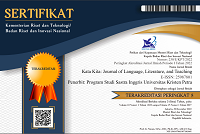Persuasive Strategies Used by Joe Biden and Kamala Harris in Their Campaign Speeches
DOI:
https://doi.org/10.9744/katakita.11.3.368-375Keywords:
Compressor, compressed air, overheatAbstract
This study aims to analyze the persuasive strategies employed by Joe Biden and Kamala Harris in their campaign speeches, guided by the theoretical framework proposed by Beebe and Beebe (2012). Through qualitative analysis of paragraphs extracted from two campaign speech transcripts, the study identifies the distinct persuasive strategies of each speaker. Joe Biden used causal reasoning, specific evidence, evidence to tell a story, concrete examples, emotion-arousing words, metaphors and similes, fear appeals, appeal to emotions of hope, appeal to emotions of courage, and shared myths, while Kamala Harris used deductive reasoning, specific evidence, evidence to tell a story, concrete examples, emotion-arousing words, fear appeals, appeal to emotions of hope, and appeal to emotions of courage.
References
Beebe & Beebe. (2012). Public speaking: An audience-centered approach (4th ed.). Pearson Education.
Biden, J (2020). Joe Biden 2020 DNC Speech Transcript. [Speech Transcript]. Rev. https://www.rev.com/blog/transcripts/joe-biden-2020-dnc-speech-transcript
Harris, K (2020). Kamala Harris Campaign Speech Transcript Reno, NV October 27. [Speech Transcript]. Rev. https://www.rev.com/blog/transcripts/kamala-harris-campaign-speech-transcript-reno-nv-october-27
Larson, C. U. (2004). Persuasion: Reception and Responsibility. Belmont: Thomson Learning Inc.
Lindsay, J. M. (2020). The 2020 Election by Numbers. CFR. https://www.cfr.org/blog/2020-election-numbers
Downloads
Published
Issue
Section
License
Authors who publish with this journal agree to the following terms:- Authors retain copyright and grant the journal right of first publication with the work simultaneously licensed under a Creative Commons Attribution License that allows others to share the work with an acknowledgement of the work's authorship and initial publication in this journal.
- Authors are able to enter into separate, additional contractual arrangements for the non-exclusive distribution of the journal's published version of the work (e.g., post it to an institutional repository or publish it in a book), with an acknowledgement of its initial publication in this journal.
- Authors are permitted and encouraged to post their work online (e.g., in institutional repositories or on their website) prior to and during the submission process, as it can lead to productive exchanges, as well as earlier and greater citation of published work (See The Effect of Open Access).














